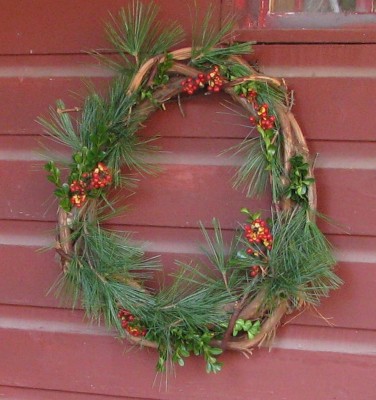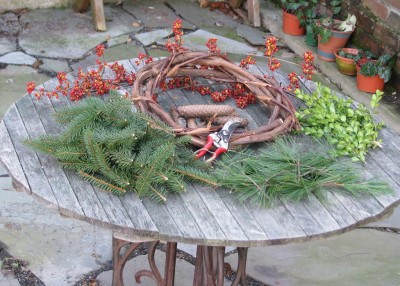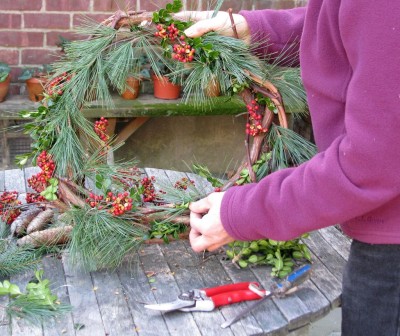Life Goes On
The dark green wreath was tied with red ribbons and gliding towards me, in its progress stirring up snowflakes gently floating out of the grey sky. No, the wreath was not hanging from a horse-drawn sled, but was plowing through the frigid air affixed to the chrome grille of a gleaming white Cadillac! Here we are in the twenty-first century, still infusing a breath of life into our winters with cut evergreen boughs, just as did the ancient Egyptians, Persians, Jews, Christians, and Druids.
Whether for Christmas, for the ancient winter festival of Saturnalia, or for any other tradition, a wreath celebrates the continuity of life through winter. Evergreens are favorite wreath materials because their year long green flaunts winters’ apparently lifeless cold.
A few evergreen boughs tied together make a doorway more inviting or a room more cozy in winter, but a bona fide wreath creates something special. And the actual making of a wreath can be an end in itself this time of year.
Plenty of native and cultivated plants, many probably growing right in your backyard, could supply evergreen leaves for wreaths. Depending on the weather and the variety, needles of some junipers might still look bright green, although many turn purplish in the cold. Norway spruce always looks rich green, as do, with a softer look, the long, slender needles of white pine. With flattened sprays of scale-like leaves, arborvitae is another good choice, surely one of the best choices for a winter wreath when you translate its name to “tree of life.”
Don’t forget broadleaf evergreens also. Mahonia, holly, leucothoe, rhododendron, boxwood, and English ivy are suitable broad-leaf evergreens for a wreath. Indoors, none of the broadleaf evergreens will hold their leaves in a wreath as long as the needle-leaved evergreens.
To get a little wilder — more in keeping with the raucous Saturnalia celebrated in ancient Rome — use some evergreens with splotches or borders of yellow on them. No evergreen has all yellow leaves, but Gold Star and Kuriwao Sunburst junipers, for example, have yellow-tipped leaves. Midas Touch and Variegata are broadleaved evergreens, varieties of Japanese holly, with spots or splotches of yellow on their otherwise green leaves.
Okay, let’s calm down and get to some practical matters. Any wreath needs a support on which to mount the branches. That support could be a purchased styrofoam “doughnut” or one you make yourself from coat hangars. For an “organic” frame, readily available from the wild or backyard pruning, grape vines come to mind. Vines of bittersweet or virginia creeper would also work. Before grabbing at any wild vine, make sure you can identify and avoid poison ivy — it can cause rashes even this time of year.
Wrap any of these vines into a doughnut shape, weaving it into itself and weaving in new lengths as you go around and around.  A few loops of string or thin wire can unobtrusively firm everything in place.
A few loops of string or thin wire can unobtrusively firm everything in place.
Next, wire, glue or tuck small bunches of evergreens onto the base, with all the bunches facing the same direction. Be generous so as to create a harmonious backdrop for the colorful stuff that comes next.
A walk in the woods or around your yard should turn up some colorful fruits, even this time of year. Still abundant are wild rose hips, bittersweet, winterberry, and barberry. Other seed pods are also good as ornaments.  Besides the obvious — pine cones — also consider the flattened silvery pods of silver dollar plant, the wiry ones of love-in-a-mist, and the shaggy manes of clematis. If yet more ornamentation is wanted, there’s always chains of cranberries or popcorn strung together.
Besides the obvious — pine cones — also consider the flattened silvery pods of silver dollar plant, the wiry ones of love-in-a-mist, and the shaggy manes of clematis. If yet more ornamentation is wanted, there’s always chains of cranberries or popcorn strung together.
When hints of spring are in the air and you tire of your wreath, just compost it or throw it in the woods (if made from all organic materials). For now, though, deck the halls.
Note: The “comments” part of these blog posts has been erratically functional. It’s fixed! So fire away. Or just send a comment to test that it’s now working. Thanks.


Hey Lee, happy new year!
My kids and I made wreaths a few weeks ago with random plants we found around the yard. I found this post enjoyable.
I am planning on planting William’s Pride and Gold Rush apple trees in the spring. I am going to take a shot at grafting Sundance, Macoun, Arkansas Black, and Liberty onto my existing trees.
Have a great 2018 and I hope we both get some apples this year!
My family has a tradition of making wreaths like yours from materials found around the yard. Our favorite frames are ones with wires every few inches that bend over the greenery (and last many years). This year I decided to expand and invite some friends. Everyone brought materials from their own yards. Grapevine (for frames), spruce, pine, hemlock, taxus, boxwood, holly (winterberry and regular), multiflora rose berries, teasel, ferns, honey locust pods, milkweed, yucca, sage, sedum, feathers, beautyberry, lavender, false blue indigo, hydrangea, and other things I have forgotten were all used. It was a blast and the results were so diverse and excellent. I think that the wreath making party will be a new tradition.
Good idea.
I very much enjoy reading your blog and look forward to the forth coming 2018 subjects. Thank you!!
You are using and advocating bittersweet vine with berries in your wreath and then throwing it in compost? Yikes! It is a terribly invasive plant.
I stand corrected. See my response to previous, similar comment.
Who knew you were crafty? Beautiful wreath, Lee!
I love reading your columns and book, but I’m astonished that you’d recommend putting wreathes with bittersweet, barberry, clematis, or multiflora berries/seeds in one’s compost or woods. Those are all dastardly invasives where i live in VT and its bad enough that that the birds spread their seed. Beyond their attractive ornamental contribution, they are a total scourge, outcompeting native plants and essentially starving wildlife because of their low nutritive value. Up here, reports are that the plumage of cardinals and other colorful birds is becoming less brilliant as a result, which makes the birds less attractive during mating season. Please remove and trash those berries and seeds before you recycle those wreaths!
Whoops. I stand corrected. Don’t throw an old wreath with berries of these invasive plants in the woods. Hot composting might do in these invasives. Or just dig a hole, not in the woods, and bury the old wreath deep. Good?
Thanks for all your posts, Lee. This time of year I keep watching and waiting for your favorite seeds to order for 2018. When you name them please include which company you order from. We tried your Hakurei turnips for the first time last year. Will definitely do them again. Do you have a favorite source for them? Had fun with the gem marigolds too.
I believe that Johnnyseeds.com is the only source for Hakurei.
Will you have Nanking cherry shrublettes for sale this spring? What month will your plant sale be in 2018?
Happy new year…..
Yes, I should have them. Contact me in early spring to make sure.
I made my first homemade holiday wreath this year. Destination was my Dad’s gravesite. I used materials from my own yard, very gratifying. A recycled wire frame from the thrift store held it all together. Cost savings allowed me to spend more on gifts for family. I was surprised at how fast it came together, after assembling all the needed materials. Even added recycled ribbon and 2 older Christmas balls with “personality”. Very proud of myself.
Also glad your comment section has been repaired. I had tried a number of times through the fall to leave remarks but was unable to make them stick.